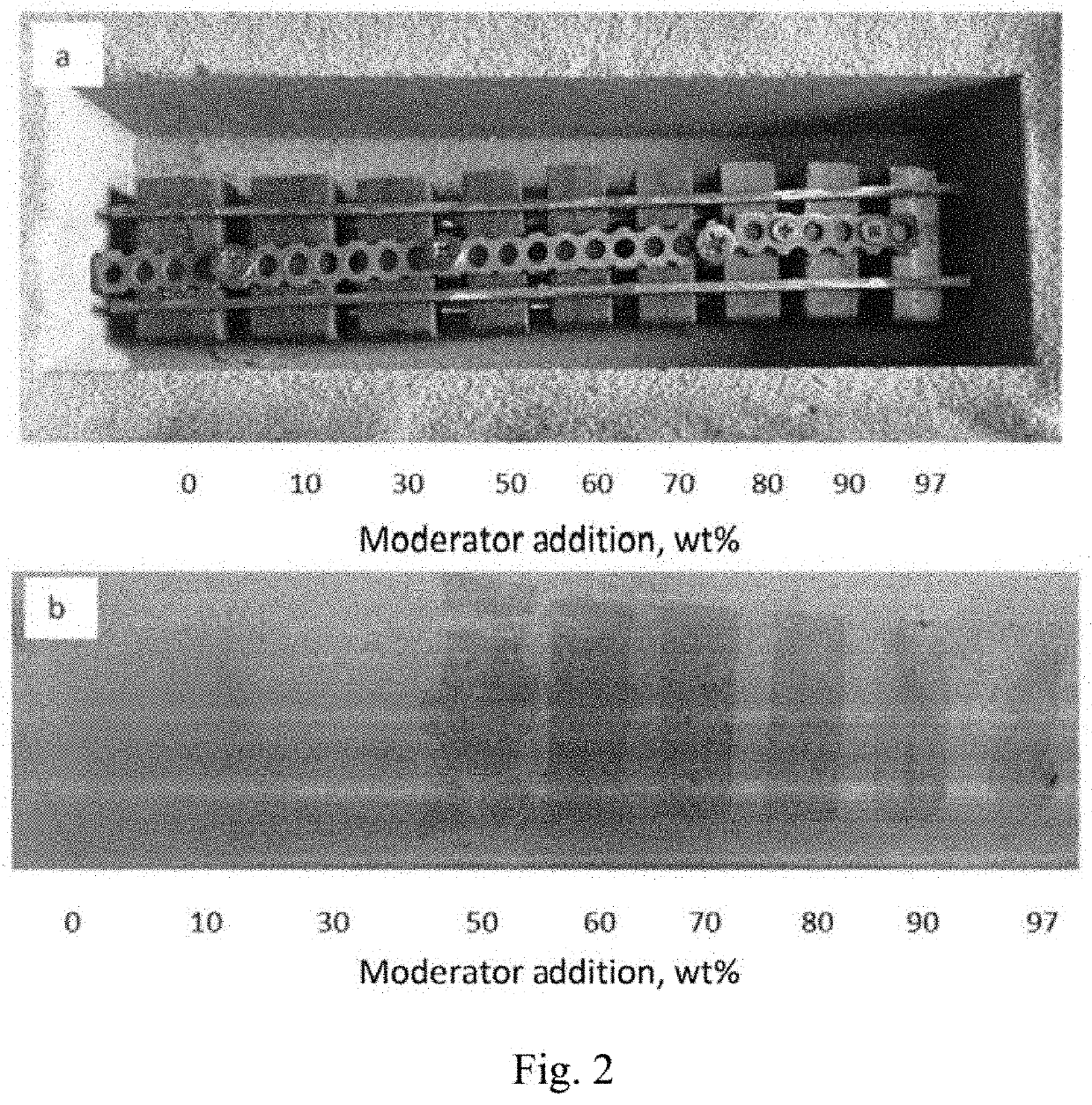Powder Composition for the Manufacture of Casting Inserts, Casting Insert and Method of Obtaining Local Composite Zones in Castings
a technology of composite zone and composition, which is applied in the direction of metal-working apparatus, transportation and packaging, etc., can solve the problems of molten alloy spreading, uneven distribution of said elements in casting, and fragmentation of composite zone, so as to increase the resistance to shock and abrasion
- Summary
- Abstract
- Description
- Claims
- Application Information
AI Technical Summary
Benefits of technology
Problems solved by technology
Method used
Image
Examples
example 1
[0042]In Example 1, the mould cavity and casting inserts were prepared for the fabrication of composite zones reinforced with TiC carbide (FIG. 1a), including the operation of fixing said casting inserts by means of an assembly system in said mould cavity (FIG. 1b). The casting inserts were made from a powder mixture comprising the reactants of TiC formation and a moderator having the composition of cast high-manganese steel containing 21% Mn. The composition of the powder mixture used for the fabrication of casting inserts and the obtained results are included in Table 1. Symbols “+” and “−” in Tables 1-6 stand for the answers “yes” and “no”, respectively, in a schematic description of the results of examinations of the polished cross-section of a casting with the composite zones fabricated by an in situ method. The chemical composition of a moderator in the form of cast Hadfield high-manganese steel is given in Table 8.
TABLE 1Sample No.A1A2A3A4A5A6Reactants of TiC formation [wt %]...
example 2
[0049]In Example 2, casting inserts were fixed in the mould cavity to produce composite zones reinforced with WC carbide as shown in FIG. 5a. The casting inserts contained the reactants of WC carbide formation and varying amounts of the powder moderator having the composition of NiHard 4 white cast iron containing Ni. The composition of the powder mixture used for the fabrication of casting inserts and the obtained results are included in Table 5. The atomic ratio of the reactants to form WC carbide was 94.93% W: 5.07% C. The moderator used for the manufacture of casting inserts E2-E9 contained the addition of a deoxidizer in the form of Al powder introduced in an amount of 2 wt %. The inserts were made by compaction under a pressure of 500 MPa and had dimensions of 20×50×X mm, where the value of dimension X depended on the compactability of individual powder compositions. Compacts E1-E8 were made from samples of powder compositions weighing 100 g each, whereas compact E9 was made f...
example 3
[0050]In Example 3, casting inserts were fixed in the mould cavity to initiate the coupled reaction of the SHS synthesis and produce the (Ti, W)C carbide as shown in FIG. 6a. The casting inserts contained the TiC and WC reactants of the coupled SHS synthesis of the (Ti, W)C carbide and varying amounts of the moderator in the form of a powder mixture having the composition of NiHard4 white cast iron containing Ni. The composition of the powder mixture used for the fabrication of casting inserts and the obtained results are included in Table 6. The weight fraction of the reactants was 50% TiC (where 55 at % Ti:45 at % C) and 50 wt % WC (where 94.93 at % W: 5.07 at % C). The moderator used for the manufacture of casting inserts F1-F4 contained the addition of a deoxidizer in the form of Al powder introduced in an amount of 5%, whereas in the case of inserts F5-F8, the amount of the deoxidizer was reduced to 0.1%. The inserts were made by compaction under a pressure of 500 MPa and had d...
PUM
| Property | Measurement | Unit |
|---|---|---|
| temperature | aaaaa | aaaaa |
| pressure | aaaaa | aaaaa |
| pressure | aaaaa | aaaaa |
Abstract
Description
Claims
Application Information
 Login to View More
Login to View More - R&D
- Intellectual Property
- Life Sciences
- Materials
- Tech Scout
- Unparalleled Data Quality
- Higher Quality Content
- 60% Fewer Hallucinations
Browse by: Latest US Patents, China's latest patents, Technical Efficacy Thesaurus, Application Domain, Technology Topic, Popular Technical Reports.
© 2025 PatSnap. All rights reserved.Legal|Privacy policy|Modern Slavery Act Transparency Statement|Sitemap|About US| Contact US: help@patsnap.com



